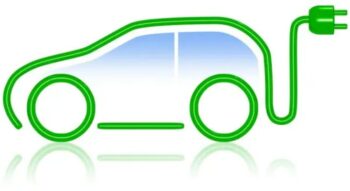On this page:
- Benefits of Driving an Electric Vehicle
- Electric Vehicles: Three Main Types
- Electric Chargers: Three Levels
- Related Resources
 Benefits of Driving an Electric Vehicle
Benefits of Driving an Electric Vehicle
- Reduce Greenhouse Gases. Every gallon of gasoline burned in your internal combustion engine (ICE) vehicle creates 20 pounds of greenhouse gases (GHG). Switching from driving an ICE vehicle to an electric vehicle (EV) is one of the most effective steps you can take to reduce your carbon footprint. This is especially true if the electricity you use is derived from renewable resources, such as wind or solar power. Learn more about climate change and fuel economy at FuelEconomy.gov.
- Save on Maintenance. Battery Electric Vehicles (All-Electric Vehicles) have many fewer mechanical parts than ICE vehicles, so they require less service. They don’t require tune-ups, oil changes, cooling system flushes, transmission service, or changing of air filters, spark plugs, and drive belts. Your maintenance costs could be reduced to a third of your previous vehicle maintenance expenditure. Learn more about EV maintenance from the U.S. Department of Energy.
- Save on Fuel. While fuel costs are volatile, it is likely that gasoline will remain more expensive than the cost of the electricity that you’ll use to power your EV, especially if you charge your EV at the less expensive Levels 1 and 2 chargers.
- Save Time. Charge your EV at home and say good-bye to gas station lines. Charge up when convenient, say, at a public charger while you shop, much like you add power to your cell phone when a charger is available. And, over the life of your EV, spend less time on maintenance.
- Enjoy the Quiet. EVs are quieter than ICE vehicles.
- Feel safe. Because EVs generally have a lower center of gravity, they are more stable and less prone to roll over than other vehicles.
Electric Vehicles: Three Main Types
- Hybrid Electric Vehicles (HEV): These vehicles combine a conventional internal combustion engine (ICE) system with an electric propulsion system. An HEV still uses gasoline but less than a comparable ICE vehicle because the engine is smaller and some of the power comes from the battery in the vehicle. HEVs get much higher miles per gallon than conventional ICE vehicles. You don’t plug this battery in to recharge it; it is recharged by the braking system in your day-to-day driving. In some HEVs, the engine shuts off temporarily when your vehicle is idling to save on fuel and improve your mileage. See FuelEconomy.gov to learn more about how HEVs work and view a tool that compares the costs of a selected hybrid with a comparably equipped non-hybrid from the same manufacturer.
- Plug-In Hybrids (PHEV): These hybrids also run on both gasoline and electricity but the battery is recharged by plugging it in and more of your mileage comes from the electric system than with an HEV. PHEVs go from 9 to 47 miles on a battery charge, depending on the vehicle and your driving conditions, before switching to gasoline for another 300+ miles of driving. The battery typically can be charged in 12 hours at a Level 1 charger (a common home outlet) or in 3 hours at a more powerful Level 2 charger. Learn more about how PHEVs work from the U.S. Department of Energy.
- Battery Electric Vehicles (BEV): BEVs (also known as “All-Electric Vehicles”) are all electric and use no gas. The driving distance ranges from 150 to 400 miles on a full charge. They are usually fully recharged in 8 hours on a Level 2 charger or 30 minutes at a DC (Direct Current) fast charger. Learn more about how BEVs work from the U.S. Department of Energy.
Electric Chargers: Three Levels
- Level 1: 120-volt, such as the common outlets in your home. This is a slow charge, typically overnight. The charging speed is 3 to 5 miles of driving range per hour of charging. Level 1 chargers work well for charging the smaller batteries in Plug-in Hybrids.
- Level 2: 240-volt outlet, such as the outlets for your clothes dryer or kitchen range. Many owners of Battery Electric Vehicles will have a Level 2 charger installed in their garage, carport, or on a post in their driveway. The charging speed is 12 to 80 miles of driving range per hour of charging, depending on the particular EV and driving conditions.
- Level 3: high voltage (400 to 900-volt) requiring a special electrical connection that normally cannot be installed at a residence and is very expensive. You will find these at locations where EV users want a fast charge (30-60 minutes) and are willing to pay more to get power quickly, such as at rest stops on highways. The charging speed is 3 to 20 miles of driving range per minute of charging. You may pay as much or more than you would for gasoline but you will benefit the environment by using electricity instead of gasoline.
Related Resources
Deciding When an EV is Right For You
🔌 Automakers Are Adding Electric Vehicles to Their Lineups. Here’s What’s Coming. (Consumer Reports)
🔌 Is It Time to Buy an Electric Vehicle? (Consumer’s Checkbook)
🔌 How to Decide If a Hybrid, Plug-In Hybrid, or Fully Electric Car Is Right for You (Consumer Reports)
Selecting the Right EV
🔌2023 Information Sheet for All-Electric Vehicles (PDF) from the Electric Vehicle Association of Greater Washington, D.C. The last sheet to include plug-In hybrid vehicles is the 2021 Information Sheet (PDF).
🔌 FuelEconomy.gov (U.S. Department of Energy and U.S. Environmental Protection Agency)
Learning How to Charge Your EV
🔌 Electric Vehicle Charging (PDF) (Montgomery County, MD Department of Environmental Protection)
🔌 What Are The Different Levels Of Electric Vehicle Charging? (Forbes)
🔌 How to Choose the Best Home Wall Charger for Your Electric Vehicle (Consumer Reports)
